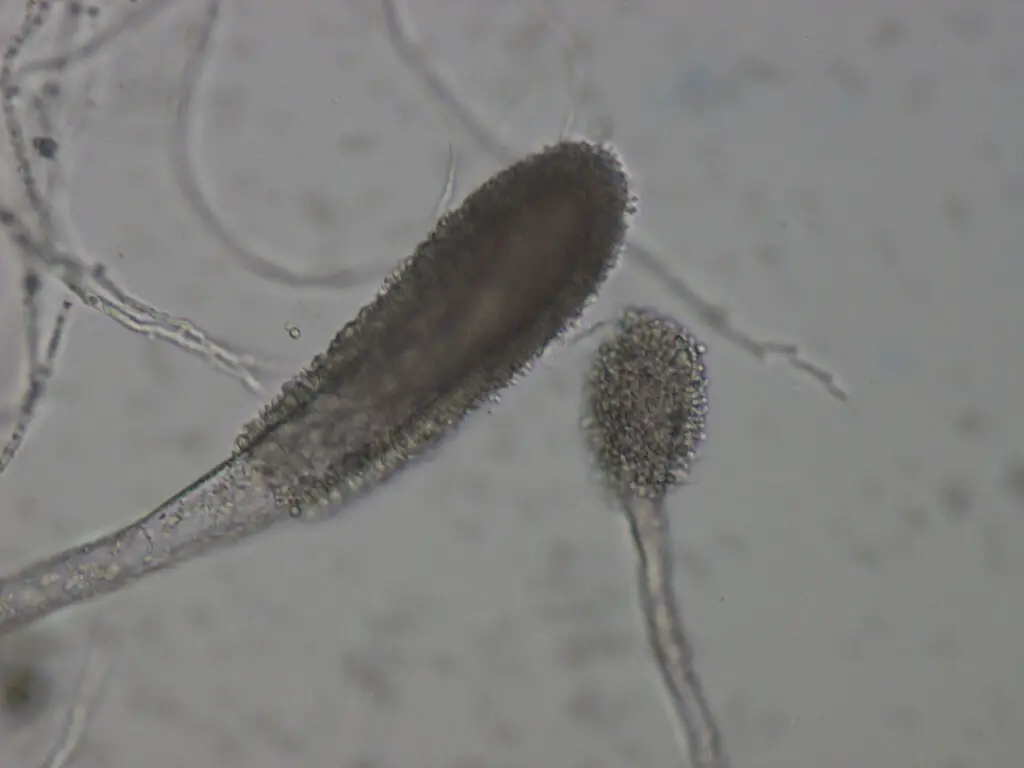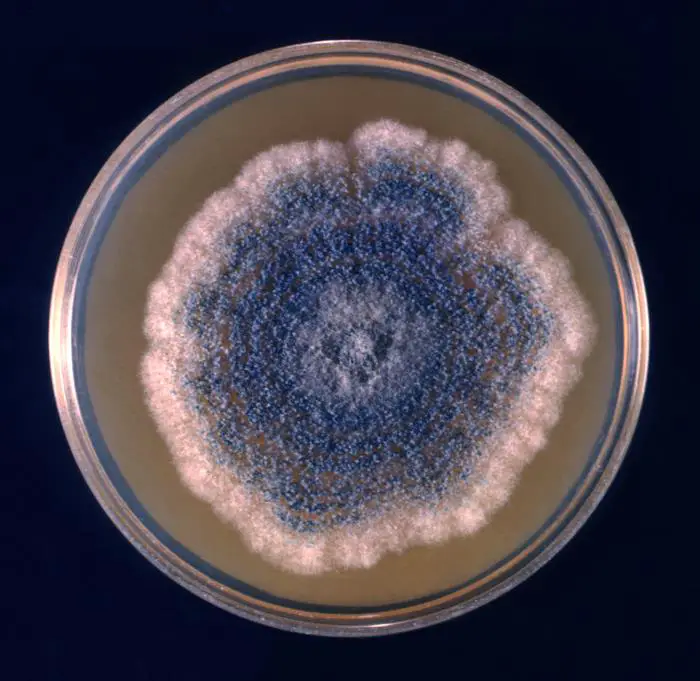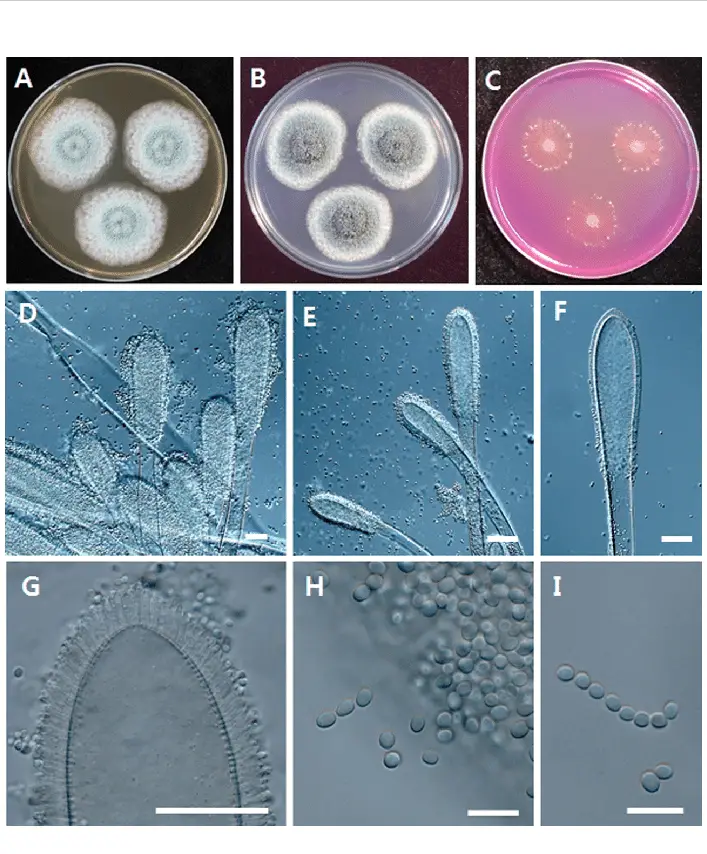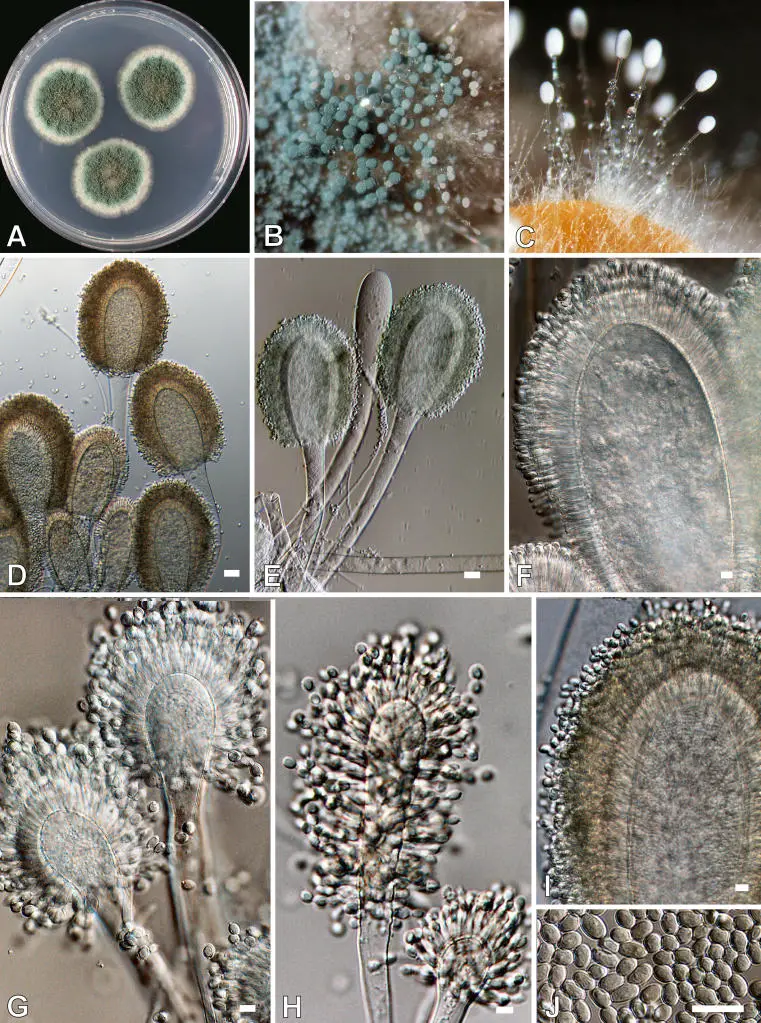Table of Contents
- Aspergillus clavatus is a genus of fungi with conidia measuring 3–4.5 x 2.5–4.5 μm. It occurs naturally in soil and animal manure. In 1834, French mycologist John Baptiste Henri Joseph Desmazières was the first to scientifically describe the fungus.
- The fungus can produce the toxin patulin, which has been linked to human and animal disease. This species is sporadic in its pathogenicity.
- Many species of Aspergillus, according to other sources, produce dry, hydrophobic spores that are readily inhaled by humans and animals.
- Due to the small size of the spores, approximately 70% of A. fumigatus spores can enter the trachea and primary bronchi, and close to 1% can enter the alveoli. Aspergillus spore inhalation poses a health concern.
- A. clavatus is allergenic and causes malt-worker’s lung, also known as occupational hypersensitivity pneumonitis.

Habitat of Aspergillus clavatus
- In addition to soil and animal manure, Aspergillus clavatus has been found in a variety of other environments. A. clavatus was detected in indoor air samples collected from residences in the southeastern United States, according to one study. Another study identified A. clavatus in hospital air and particulate samples in Iran. This indicates that this fungus has the potential to be a widespread domestic air contaminant.
- In addition, A. clavatus has been isolated from a variety of organic sources, including decaying plant matter, avian droppings, and fermented foods. Additionally, it has been discovered in the digestive tracts of animals such as cattle and swine.
- Aspergillus clavatus has been the subject of research concerning its potential biotechnology applications due to its ability to grow at a wide range of temperatures and in a variety of organic materials. A. clavatus, for instance, has been studied for its ability to produce enzymes that can be utilised in the food industry and in the production of biofuels.
- Aspergillus clavatus is a fungus that inhabits a variety of environments, including soil, animal manure, indoor environments, and organic matter. Its adaptability to a wide range of temperatures and prospective biotechnology applications make it an organism worthy of further study.
Morphology of Aspergillus clavatus
Aspergillus clavatus is a filamentous fungus that belongs to the Ascomycota division. Its morphology is characterized by the following features:

- Colonies: Aspergillus clavatus forms colonies that are initially white, but turn yellow-green as they mature. The colonies have a woolly texture and a flat surface.
- Hyphae: The fungus has hyphae that are septate, meaning they are divided into cells by cross-walls. The hyphae are typically 2-4 μm in diameter and grow in a branching pattern.
- Conidiophores: Aspergillus clavatus produces conidiophores, which are specialized hyphae that bear the conidia (asexual spores). The conidiophores are typically unbranched and are usually 400-600 μm in length.
- Conidia: The conidia of Aspergillus clavatus are produced in chains at the tips of the conidiophores. They are spherical or oval-shaped, smooth-walled, and have a size of 2.5-3.5 μm in diameter. The conidia are typically green in color, but can also be yellow or brown.
- Cleistothecia: Aspergillus clavatus can also produce sexual structures called cleistothecia. These are spherical structures that contain the sexual spores (ascospores) of the fungus. The cleistothecia are about 200-300 μm in diameter and are covered with small projections called perithecial appendages.
Cultural Characteristics of Aspergillus clavatus

- Colony morphology: A. clavatus colonies are bluish-grey green in colour, velvety, and moderately dense. At 25°C, they can expand to a diameter of up to 2 cm in just seven days.
- Microscopic morphology: The conidiophores of A. clavatus are hyaline, smooth-walled, and coarse at the microscopic level. They have a maximum length of 1000 μm. The vesicles are found at the apex of the conidiophores and are clavate, or club-shaped. On the vesicles, the phialides are organised in a single layer. The conidia are 2-4 μm in diameter and globose or ellipsoidal in shape. They have a finely rough surface and are green in colour.
- Growth rate: On Sabouraud dextrose agar (SDA), A. clavatus grows quickly. At 25°C, colonies can grow to a diameter of 2 cm in 7 days.
- Temperature range: A. clavatus may thrive in a wide variety of temperatures, including those between 5°C and 45°C. 25°C is the ideal growing temperature.
- pH range: The pH range that A. clavatus may grow in is from 3 to 10. For growth, a pH of 5.5 is ideal.
- Requirements for oxygen: A. clavatus is a facultative aerobe, which means it can flourish with or without oxygen. However, oxygen promotes growth more quickly.
- Nutrient requirements: A. clavatus is a heterotroph, which means that in order to thrive, it needs organic resources. Carbohydrates, proteins, and lipids are the three nutrients that are most critical for growth.
- Inhibition by other fungi: Other fungus can restrict the growth of A. clavatus, including Aspergillus fumigatus and Aspergillus niger.
- Carbohydrate assimilation: A. clavatus is capable of assimilating a range of sugars, including glucose, sucrose, maltose, lactose, and starch.
- Production of pigments: A. clavatus is capable of producing a range of pigments, such as green, yellow, and brown pigments.
- Toxin production: A. clavatus is capable of producing a number of toxins, including the strong carcinogen patulin.


Culture media used for the growth of Aspergillus clavatus
Many different culture media can be used to grow Aspergillus clavatus, however the most popular ones are Sabouraud dextrose agar (SDA), Czapek yeast extract agar (CYA), and Malt extract agar (MEA).
- SDA is a versatile, glucose-enriched medium for fungus growth. It works well for cultivating a wide range of fungus, including A. clavatus. Sabouraud dextrose agar (SDA) Composition
- Ingredients:
- 20 g D-glucose
- 20 g agar
- 10 g peptone
- 5 g K2HPO4
- 2 g MgSO4.7H2O
- 1000 mL distilled water
- Preparation:
- Dissolve the ingredients in the distilled water in a flask.
- Heat the mixture until it boils, stirring constantly.
- Cool the mixture to 45-50°C.
- Pour the mixture into petri dishes.
- Allow the plates to cool and solidify.
- Ingredients:
- The slightly more complex CYA media contains yeast extract, which gives the fungus extra nutrients. It is a fantastic option for cultivating fungi like A. clavatus that need additional nutrients. Czapek yeast extract agar (CYA) composition;
- Ingredients:
- 10 g D-glucose
- 5 g yeast extract
- 1 g K2HPO4
- 0.5 g MgSO4.7H2O
- 1000 mL distilled water
- Preparation:
- Dissolve the ingredients in the distilled water in a flask.
- Heat the mixture until it boils, stirring constantly.
- Cool the mixture to 45-50°C.
- Pour the mixture into petri dishes.
- Allow the plates to cool and solidify.
- Ingredients:
- Malt extract, which is present in MEA and is a rich medium, offers the fungus a range of nutrients. It works well for cultivating fungus like A. clavatus that need a lot of nutrients. Malt extract agar (MEA) composition;
- Ingredients:
- 10 g malt extract
- 5 g D-glucose
- 1 g K2HPO4
- 0.5 g MgSO4.7H2O
- 1000 mL distilled water
- Preparation:
- Dissolve the ingredients in the distilled water in a flask.
- Heat the mixture until it boils, stirring constantly.
- Cool the mixture to 45-50°C.
- Pour the mixture into petri dishes.
- Allow the plates to cool and solidify.
- Ingredients:
Growth on Czapek’s solution agar
On Czapek’s solution agar, Aspergillus clavatus colonies expand quickly, reaching 3.0-3.5 cm in 10 days at 24-26 °C. Growth is typically planar or mildly furrowed, with the occurrence of floccose strains on occasion. However, in most cases, a mycelial felt surface layer that is rather thin and produces a large number of erect conidiophores is seen. The reverse is typically colourless but, in certain strains, turns brown over time. While odour isn’t particularly noticeable in some strains, it can be really offensive in others. When young, large conidial heads measure 150 to 200 by 300 to 400 μm. They eventually divided into two or more divergent and compressed cordial chains, reaching a thickness of 1.00 mm, and their coloration ranged from slate olive to artemisia green. The measured conidiophores have a diameter of 20–30 μm and a length of up to 1.5–3 mm. They gradually grow until they enlarge into a clavate vesicle at the apex, which has a fertile region that is between 200 and 250 μm long and 40 to 60 μm wide. The sterigmata typically measures 2.5 to 3.5 μm by 2.0 to 3.0 μm at the vesicle’s base, rising to 7.0 to 8.0 μm or, less frequently, 10 μm to 2.5 to 3.0 μm at the apex. The conidia measure 3.0 to 4.5 μm by 2.5 to 3.5 μm and have a somewhat thick wall. While they may be bigger in some strains, others may have an erratic appearance.
Growth on malt extract agar
A. clavatus appears to have a distinct structural morphology on malt extract agar than on Czapek’s solution agar. The typical isolates isolated from malt media have fewer conidial structures that are potentially larger in size. In non-typical genotypes, the number of conidial heads increases while their size decreases. The conidiophores are between 300 and 500 μm in length and have loose, columnar crowns. Non-typical strains are odorless, whereas typical strains possess a pungent and disagreeable odor.After six days of observation, one conidium on malt extract agar produced colonies containing 25X107 conidia.
Life Cycle of Aspergillus clavatus
Aspergillus clavatus is a species of fungus that belongs to the Aspergillus genus. Like other Aspergillus species, A. clavatus has a complex life cycle that includes both sexual and asexual reproduction.
The life cycle of A. clavatus can be summarized in the following stages:
- Spore germination: The life cycle begins with the germination of spores. These spores can be dispersed by air, water, or other means and can survive for a long time in the environment. When the conditions are favorable, the spores germinate and grow into hyphae.
- Hyphal growth: The hyphae grow and branch, forming a network of interconnected structures that can penetrate and absorb nutrients from the surrounding environment. The hyphae can also produce asexual spores, which are called conidia.
- Asexual reproduction: A. clavatus produces conidia through a process called conidiogenesis. The conidia are produced at the tips of specialized structures called conidiophores. These conidia are small, lightweight, and can be easily dispersed by air or water.
- Sexual reproduction: A. clavatus can also undergo sexual reproduction when two compatible strains meet. In this process, two hyphae of opposite mating types come into contact and fuse, forming a structure called a zygospore. The zygospore contains the genetic material from both parents and can survive in harsh environmental conditions.
- Zygospore germination: When the conditions are favorable, the zygospore germinates and forms a new mycelium, which can produce both asexual and sexual spores.
Pathogenesis of Aspergillus clavatus
Aspergillus clavatus is a fungus that can induce aspergillosis and other infections in humans. The pathogenesis of an Aspergillus clavatus infection is not completely understood, but the following steps are believed to be involved:
- Spore inhalation is a cause of disease: Aspergillus clavatus infection begins with the inhalation of spores. The spores are very small and light, allowing them to be dispersed readily by the wind. Additionally, the particles can be transmitted via contact with contaminated surfaces or objects.
- Germination of spores: Aspergillus clavatus spores can germinate in the airways if inhaled. Germination is the process whereby spores begin to develop. The spores release enzymes that degrade the neighboring tissue, thereby facilitating the growth of the fungus.
- Invasion of the lungs: The fungus can then invade the lungs and develop in the alveoli, the tiny air sacs in the lungs. The bronchi, which are the tubes that convey air to and from the lungs, are also susceptible to fungus growth.
- Inflammation: The development of the fungus in the airways can result in inflammation. Inflammation is the response of the body’s immune system to infection or injury. Inflammation can cause lung injury and a variety of symptoms, including fever, cough, and shortness of breath.
- Dissemination: In certain instances, the fungus can travel from the lungs to other organs, including the brain, heart, and kidneys. This is known as disseminated aspergillosis, and it is a potentially fatal condition.
The pathogenesis of an infection caused by Aspergillus clavatus is complex and incompletely understood. However, it is believed that the aforementioned processes contribute to the development of the infection.
Several factors can increase the likelihood of developing an Aspergillus clavatus infection. These elements include:
- Chronic lung diseases, such as asthma and cystic fibrosis
- Immunosuppression, such as from cancer chemotherapy or organ transplantation
- Diabetes
- Old age
- Smoking
- Exposure to mold
Diseases caused by Aspergillus clavatus
- Aspergillosis: Aspergillosis is an infection caused by fungi that can affect the airways, sinuses, and other organs. Aspergillosis is most prevalent in individuals with compromised immune systems, such as those suffering from cancer, organ transplantation, or AIDS.
- Allergic bronchopulmonary aspergillosis (ABPA): This is a chronic lung condition induced by an allergic reaction to the spores of Aspergillus clavatus. Most individuals with asthma or cystic fibrosis have ABPA.
- Extrinsic allergic alveolitis (EAA): Extrinsic allergic alveolitis (EAA) is a lung disorder induced by an allergic reaction to inhaled Aspergillus clavatus spores. EAA is most prevalent among employees who are exposed to mold, such as farmers, brewers, and mushroom harvesters.
- Invasive aspergillosis: Aspergillosis invasive is a serious infection that can extend to the brain, heart, and kidneys, among other organs. Most cases of invasive aspergillosis occur in individuals with compromised immune systems.
- Aspergilloma: Aspergilloma is a fungus mass that develops in the airways. Aspergillomas are typically harmless, but they can occasionally produce fever, cough, and shortness of breath.
- Aspergillus sinusitis: This is an infection of the sinuses caused by the fungus Aspergillus clavatus. Aspergillus sinusitis is characterized by fever, facial pain, and nasal obstruction.
- Aspergillus otomycosis: Aspergillus otomycosis is an infection of the ear produced by the fungus Aspergillus clavatus. Aspergillus otomycosis symptoms can include ear discomfort, hearing loss, and ear drainage.
Treatment of Aspergillus clavatus diseases
The treatment of Aspergillus clavatus diseases depends on the type and severity of the infection, as well as the overall health status of the patient. The following are some of the treatment options for A. clavatus infections:
- Antifungal medications: Antifungal medications are the mainstay of treatment for A. clavatus infections. These medications include azoles, polyenes, and echinocandins. The choice of medication depends on the type and severity of the infection, as well as the patient’s age, weight, and kidney function. The duration of treatment varies depending on the response to therapy and the risk of recurrence.
- Voriconazole
- Posaconazole
- Isavuconazole
- Itraconazole
- Amphotericin B
- Surgery: In some cases, surgery may be necessary to remove infected tissue, such as in cases of aspergilloma or invasive aspergillosis that do not respond to antifungal medications. Surgery may also be necessary to relieve obstructions caused by fungal growth or to drain abscesses.
- Supportive care: Supportive care, such as oxygen therapy, bronchodilators, and fluid management, may be necessary for patients with respiratory infections or other complications.
- Prevention: Prevention of A. clavatus infections is important, especially for immunocompromised individuals. Measures such as infection control practices, air filtration, and antifungal prophylaxis may be recommended.
Prevention and control of Aspergillus clavatus
- Avoiding exposure to mold: Aspergillus clavatus is commonly found in soil, air, and water and should be avoided. Mold-infested areas, such as construction sites, damp basements, and old structures, should be avoided.
- Wearing a mask when working in dusty areas: If you must work in a dusty area, such as a construction site, you should wear a mask to prevent imbibing mold spores.
- Maintaining a tidy and dry home: Mold grows best in damp environments. To prevent mold growth, maintain a clean and dry residence. This includes promptly cleaning up any spills or leakage and operating the dehumidifier in humid climates.
- Improving ventilation: The removal of mold particles from the air can be aided by improving ventilation. If you have a mold problem in your home, open windows and operate fans to improve ventilation.
- Taking medication: If you are at a high risk for developing an Aspergillus clavatus infection, your physician may prescribe antifungal medication to prevent the infection.
FAQ
What is Aspergillus clavatus?
Aspergillus clavatus is a species of fungus that can cause a variety of diseases in humans, ranging from mild allergic reactions to severe invasive infections.
What are the symptoms of Aspergillus clavatus infection?
The symptoms of Aspergillus clavatus infection depend on the type and severity of the infection, but can include fever, cough, shortness of breath, chest pain, skin lesions, and ear pain and discharge.
How is Aspergillus clavatus infection treated?
Treatment of Aspergillus clavatus infections involves antifungal medications, surgery, and supportive care. The choice of treatment depends on the type and severity of the infection.
What are the risk factors for Aspergillus clavatus infection?
Individuals who are immunocompromised, such as those with HIV/AIDS, cancer, or organ transplants, are at higher risk for Aspergillus clavatus infections. However, healthy individuals can also develop infections with this fungus.
How can I prevent Aspergillus clavatus infection?
Prevention of Aspergillus clavatus infections involves infection control practices, air filtration, antifungal prophylaxis, environmental control, and patient education.
What are the complications of Aspergillus clavatus infection?
Complications of Aspergillus clavatus infection can include tissue damage, organ failure, and death, especially in severe or invasive infections.
What is the prognosis for Aspergillus clavatus infection?
The prognosis for Aspergillus clavatus infection depends on the type and severity of the infection, as well as the underlying health of the affected individual. In general, early diagnosis and treatment can improve outcomes.
What is the research on Aspergillus clavatus?
Research on Aspergillus clavatus focuses on improving diagnostic techniques, developing new antifungal therapies, and understanding the molecular mechanisms of the fungus.
What are the latest developments in the treatment of Aspergillus clavatus infection?
Recent developments in the treatment of Aspergillus clavatus infection include the use of combination antifungal therapy, new formulations of existing antifungal drugs, and the development of novel antifungal agents.
What are the latest developments in the prevention of Aspergillus clavatus infection?
Recent developments in the prevention of Aspergillus clavatus infection include the use of prophylactic antifungal agents, the implementation of infection control measures, and the development of new air filtration technologies.
References
- Seye F, Faye O, Ndiaye M, Njie E, Marie Afoutou J. Pathogenicity of the Fungus, Aspergillus clavatus, isolated from the locust, Oedaleus senegalensis, against larvae of the mosquitoes Aedes aegypti, Anopheles gambiae and Culex quinquefasciatus. J Insect Sci. 2009;9:1-7. doi: 10.1673/031.009.5301. PMID: 20050773; PMCID: PMC3011963.
- Samson, R.A., et al. (2014). Aspergillus systematics in the genomic era. Studies in Mycology, 78, 49-71.
- Vesper, S.J., et al. (2007). Quantitative PCR analysis of molds in the dust from homes of asthmatic children in North Carolina. Journal of Environmental Monitoring, 9, 826-830.
- Dehghan, P., et al. (2017). Investigation of Aspergillus fumigatus and Aspergillus clavatus in indoor air and dust from hospitals in Kerman, Iran. Journal of Hospital Infection, 96(1), 78-83.
- https://www.sciencedirect.com/topics/biochemistry-genetics-and-molecular-biology/aspergillus-clavatus
- https://www.ncbi.nlm.nih.gov/Taxonomy/Browser/wwwtax.cgi?mode=info&id=5057
- https://en.wikipedia.org/wiki/Aspergillus_clavatus
- https://www.sciencedirect.com/topics/agricultural-and-biological-sciences/aspergillus-clavatus


